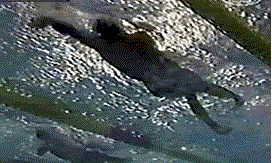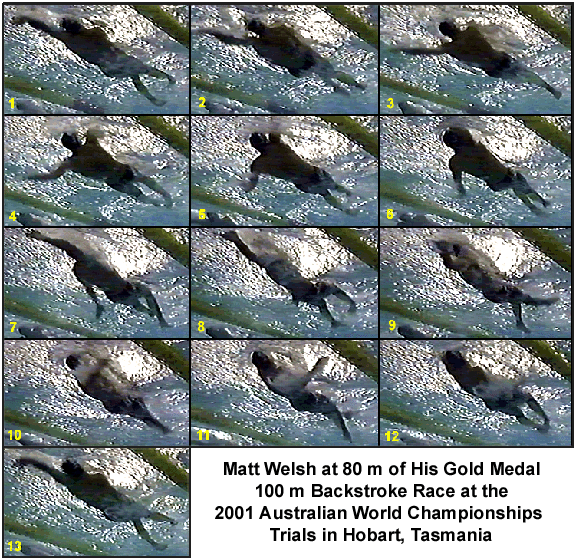HOW CHAMPIONS DO IT
Researched, produced, and prepared by Brent S. Rushall,
Ph.D., R.Psy.

MATT WELSH AT 80 m OF HIS GOLD MEDAL 100 m BACKSTROKE RACE AT THE 2001 AUSTRALIAN WORLD CHAMPIONSHIPS TRIALS IN HOBART, TASMANIA
This stroke analysis includes a moving sequence in real time, a moving sequence where each frame is displayed for .5 of a second, and still frames.
The following image sequence is in real time. It will play through 10 times and then stop. To repeat the sequence, click the browser's "refresh" or "reload" button.

The following image sequence shows each frame for half a second. It will play through 10 times and then stop. To repeat the sequence, click the browser's "refresh" or "reload" button.

At the end of the following narrative, each frame is illustrated in detail in a sequential collage.
Each frame is .1 seconds apart. Matt Welsh's time for this event was 54.43 seconds, the #1 ranked swim in the world for this distance as of June 08, 2001.
Notable Features
Several good features of technique are evident in this stroking sequence.
- Upon entry (frames #1 and #8), the swimmer begins to orient movements to produce backward force. There is no downward movement, which is traditionally associated with an "S"-shaped pulling pattern.
- Early force production, that is pushing backward, is demonstrated in frame #2 and #9.
- The ends of the propulsive phases employ an inward and upward sculling action.
- The head is well back in the water. It assists the hips to stay in the "shadow" of the shoulders.
- Streamline of the head-body posture is good.
- The shoulders and hips roll together (frame #4 and #9). This roll is assisted by a kick with the leg on the same side as the pulling arm very early in the propulsive phase (frame #2 and #8). That kick rotates the same-side hip downward.
There are some technique features that could be improved.
- The right arm entry is too far behind the head. It has to move laterally to be positioned where it can initiate a productive movement. The reader should contrast the entry position of the left arm (frame #1 and #13) and the right arm (frame #7) to see an efficient versus an inefficient entry.
- The major technique fault involves the position of the arms during the propulsive phase. Particularly with the left arm, there is not enough flexion at the elbow during the pull. The propelling surface moves laterally, creating torque that needs to be offset by a counteracting lateral kick (the right leg in frames #3-5). This "long" left arm is not as strong as it could be. By bending more at the left elbow, the following could be achieved:
- propulsion would be more direct reducing wave resistance and frontal resistance;
- propulsion would be stronger (more muscles would function in more effective positions);
- the time for the propulsive phase would be shortened allowing a higher rate of stroking; and
- an overall saving of energy and reduction in specific localized fatigue in each stroke.
- It is not possible to view the "length" of the right arm accurately from this perspective.
Matt Welsh could swim faster with these technique modifications.

Return to Table of Contents for this section.






